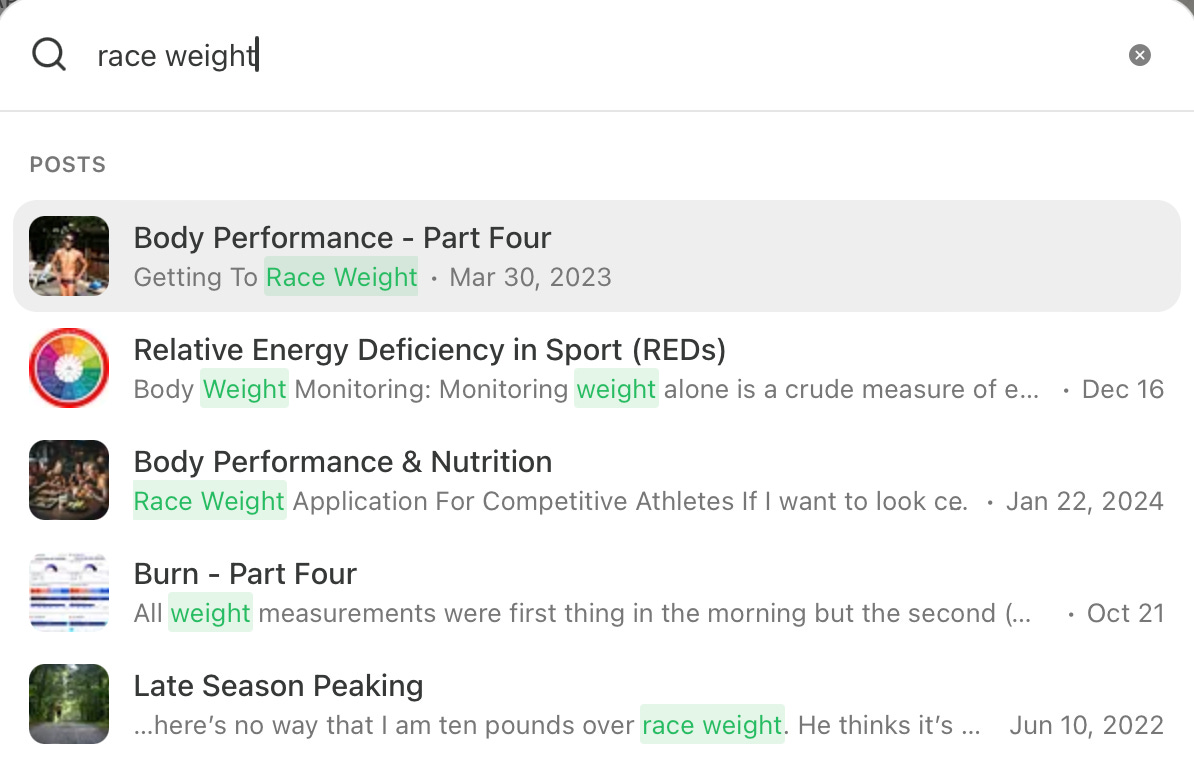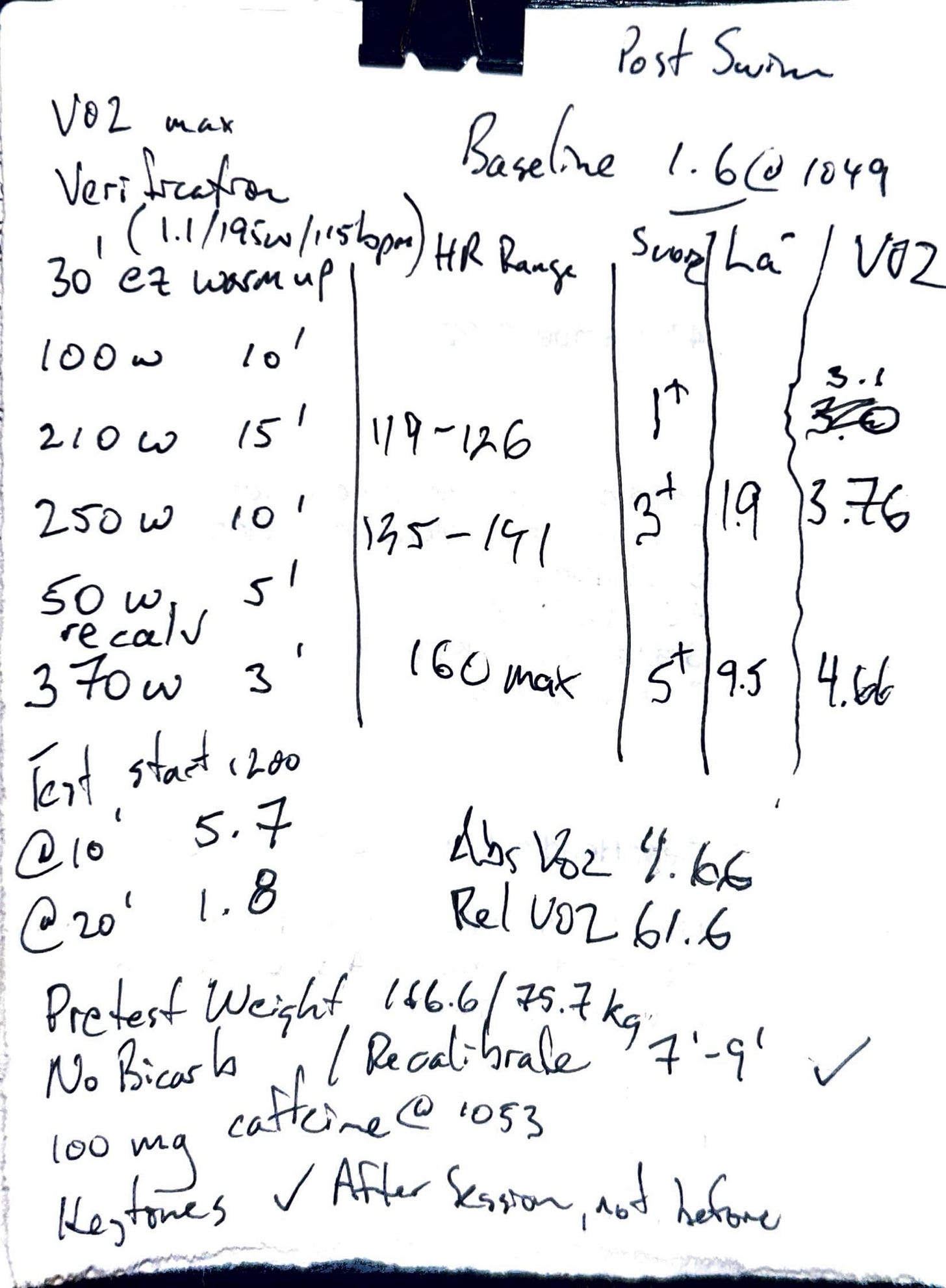You can access Part One here. All those tips continue to roll forward.
I writing a series called the Physics of Performance that’s more general than this article.
From that series:
This leaves us with four choices for structuring our training:
Endurance and Strength - Build General Capacity
Race Specificity - Build Specific Capacity
VO2 Max - Increase The Size of Our Engines
Rejuvenation - Enable Long Term Upward Performance Progression
The pattern I’ll be using this year is: VO2, Endurance & Strength, Race Specificity then Rejuvenation.
VO2 Block
I had a running injury in January, which proved fortuitous (for my cycling). I was able to give a full effort to my VO2 Block. I had a number of sessions which were 10/10 for effort, something I rarely do.
I saw my Pmax increase from 320w to 340w and my P3 increase from 350w to 370w.
Interestingly, my VO2 Max, measured in liters of oxygen (using VO2Master unit), did not increase.
Even more interesting, my LT1 and LT2 power increased by more than my top end.
The Red Zone work (combined with consistent training and a high-volume Tucson camp) resulted in improvements in all zones, my LT1 and LT2 power improved more than my top end.
This thread on X covers the specifics of my VO2 Block. You will find my protocol, the study it was based on, workout samples and results. I did fewer sessions than the full protocol and spread the workouts wider than the protocol.
Train Heavy, Race Light(er)
I kept my weight up from January to March. The idea being to see if I’d recover faster when heavier. I’d heard about this from Olav Aleksander Bu and wanted to give it a try.
Weight gain didn’t have any adverse effects and I seemed to tolerate the VO2 Block well. At 80kg, I feel heavy and my belly jiggles (!) so it’s a bit tough mentally.
I wasn’t overweight as my BMI was 24.2 at the peak. Kristian’s BMI peaked at 26.5 in the three-year study of his training, energy burn and physiology.1
What surprised me was how easy it was to drop 3kg in the three weeks before Oceanside 70.3. I have a physiology where I gain, and lose, fat easily. My body is exceptionally good with energy uptake (a topic you’ll hear Olav Aleksander discuss).
However… with the weight loss… Olav Aleksander mentioned that Kristian saw his absolute AND relative VO2 Max decline when he lost weight.
So I did something I never do…
I performed a VO2 Max Verification test in the middle of race week (Tuesday for a Saturday race), a true max effort.
I’d ridden long the day before, so could have been a little tired.
I didn’t hit season highs for HR or lactate.
I did hit season high for best 3-minute power.
Unlike Kristian, my weight loss didn’t result in a decline in top end power or absolute VO2 Max.
Given it’s much easier to run a submax marathon at 75kg than 80kg, I will try to manage my weight back down in June. “Management” might not be required. Last year (like most others), I lost weight naturally as volume and my big days ramped up.
If “management” is required my strategy is simple:
Keep eating my core nutrition plan.
Limit sports drink intake on low volume days.
Eat breakfast after first session on low volume days.


Run Plan
I ran great at Oceanside (1:29 off the bike) so we’re going to lean into my run fitness and prepare for a fast marathon.
From last time…
Specific Preparation: given I’m likely to be recovery limited during specific preparation, consider a session (that sounded very Norwegian). 10-16x 800m holding Open Half Marathon Pace with 1 minute passive recovery after each rep. The idea is to hold Threshold velocity but only generate Tempo lactate/stress.
What we will target is two rounds of the HM 800s. They will be spaced ~10 days apart and progress by session… 10/13/16 & 10/13/16. Six sessions total. I’ll be surprised if I get all six done, that’s the max.
First time through the progression, I do a double run (same day) with an easy 30-40 minutes. With the double run, ~2 hours of running.
Second time through the progression, the double run includes 8x400 at 10K pace on 1’ passive rest. Creating a Double Threshold-ish session.
As well, a traditional Long Run every ~14 days. Long run alternates between flats and hills. If you live in Boulder, flat is LoBo Trail and hills are Mesa Trail/Green & Bear Mtns.
Everything will end up on Strava if you want to play along at home.
Races & Race Sims
I have a 5K late April and a Half Marathon in early May.
Four weeks out from Roth I have an Olympic Tri and Three weeks out I have Boulder 70.3.
Race sims follow the advice I shared in my Guide to Going Long, see Part One: Races & Supporting Events (Mid April, Late May, Late June).
The video below explains the best workout for Ironman… ie a Race-Sim Combination workout across two days.
Swim, Bike & Testing
I’m going to use April to re-establish my swim strength. Then focus my energy on big days, long rides and running. I see the swim as the warm-up for an Ironman. Key thing is to maintain my metabolic fitness in the water, across 2.4 miles.
“Strength” in a bike sense will mean hills, including 5x1 mile sets (TT position) uphill.
May starts with a high-volume bike-focused training camp in Italy. I did this last year and it worked great.
Not sure what “Ironman Power” is right now. Julie asked me my thoughts when we met. I used 230w for “Zone 2” when I was at my Tucson Camp and that felt appropriate for that type of training. It was also the power I held at the end of Oceanside, riding on the flats back to the coast.
Before, and after, my Italy Camp, I will do lab, and field, testing to see where my LT1 is sitting. To date, all testing has been in road position.
Returning to Helsinki in May, with my TT bike, for lab testing at the Olympic Training Center. I wrote a Testing Series after my trip last year.
One of my mantras is remember what worked and keep it in the plan. Consistent volume works for me, so that’s the focus.
You can access my notes of Kristian’s study here.






